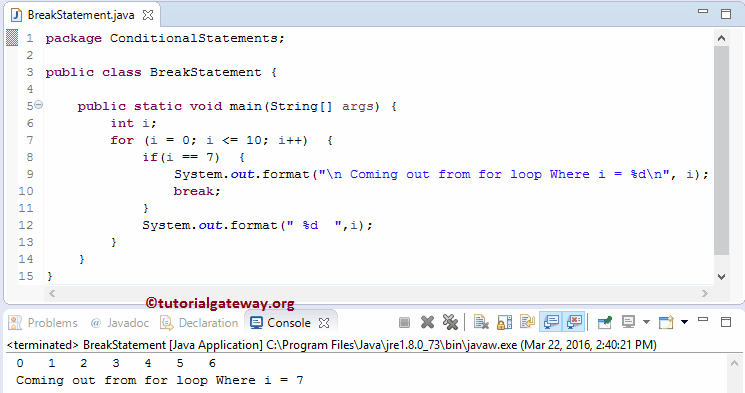The Java break and continue are two important statements used to alter the flow of a program in any programming language.
In Java Programming, Loops are useful for performing a specific block of code for n number of times until the test condition is false. There will be some circumstances where we must stop the loop without completing all the lies of code. In these situations, we can use this Java break and continue statements.
Java break Statement
The Java break statement is very useful for exiting any loop, such as For, While, and Do While. While executing them, if the Javac compiler finds the break statement inside them, it will stop executing the statements and immediately exit from the loop.
For example, we have ten lines of code inside the loop, and we want to exit from the loop when a specific condition is True; otherwise, it has to perform all of them. In this situation, we can use the If clause to check for the condition and place the break statement inside the If block. If the condition is True, Java will execute the break statement and exit the controller from the loop entirely. Otherwise, it will execute all the lines of code.
The Break statement is the most important one in Switch Case. The compiler will not exit from the switch cases without using this one. The syntax of the Break Statement in Java Programming language is as follows:
break;
Java break statement examples
We want to share two examples to display the working functionality of the Java Break statement in both For loop and the While loop.
For Loop
This program uses the Java break statement inside the for loop to exit from loop iteration.
package ConditionalStatements;
public class BreakStatement {
public static void main(String[] args) {
int i;
for (i = 0; i <= 10; i++) {
if(i == 7) {
System.out.format("\n Coming out from for loop Where i = %d\n", i);
break;
}
System.out.format(" %d ",i);
}
}
}

In this example, First, We initialized the value of i as i = 10 at the beginning of the code. Within the For loop, we initialized the value of i as i = 0, and the condition will check whether i is less than or equal to 10. Lastly, we used the Increment Operator to increment the value by 1.
Please refer to the For, While, Do While, If condition, and Continue articles in Java Programming to understand them.
Inside the For, we placed the If condition to test whether i equals 7.
- If the condition is false, it will skip the Break statement and print that number as output (In Our case, 0, 1, 2, 3, 4, 5, 6).
- If this condition is True, it will execute, and the iteration will stop at that number without printing the System.out.format(“%d”, i).
Java break Statement in a While loop
In this program, we will use the break statement inside the While loop to exit from the loop iteration.
package ConditionalStatements;
public class BreakinWhile {
public static void main(String[] args) {
int i = 10;
while ( i > 0) {
if(i == 4) {
System.out.format("\n Coming out from While Where i = %d", i);
break;
}
System.out.format(" %d ",i);
i--;
}
}
}
10 9 8 7 6 5
Coming out from While Where i = 4Within this Java Break Statement example, First, We initialized the value of i as i = 10 at the beginning of the code. Within the While loop, we check for the condition whether i is greater than 0 or not.
while ( i > 0) {
Inside the While, we placed the if condition to test whether i is equal to 4.
- If the condition is false, it will skip it and prints that number as output (In Our case, 10, 9, 8, 7, 6, 5).
- If this condition is True, the statement will execute, and the iteration will stop at that number without printing the System.out.format(“%d”, i).

Comments are closed.